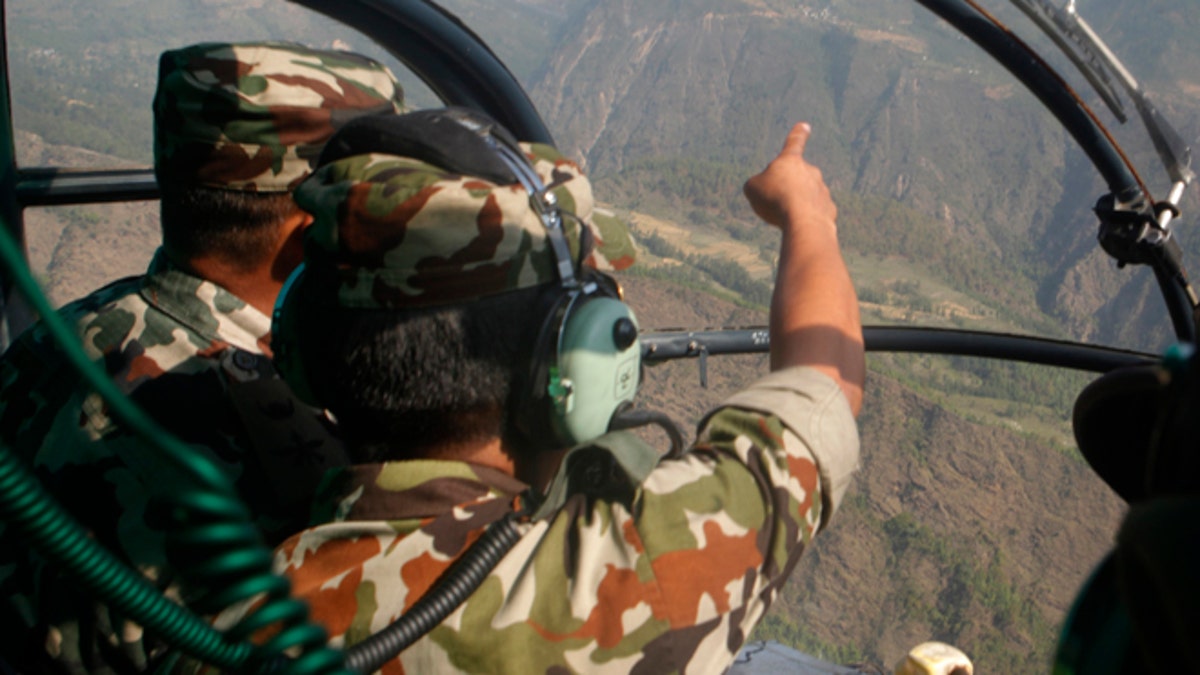
May 14, 2015: Nepalese army men search for the missing U.S. Marine helicopter in the earthquake affected Dolakha District, Nepal. (AP)
U.S., Indian and Nepali military helicopters and a drone were combing the dense forests of Nepal Thursday for signs of a Marine helicopter that vanished while delivering aid to the quake-ravaged nation.
The Huey helicopter – carrying six Marines and two Nepali soldiers – disappeared Tuesday, but the Marine Corps says there is no indication that it has crashed. The crew was last heard over the radio saying the helicopter was having fuel problems.
"We are using infrared vision to look for hotspots and any signs of life," drone operator Shepherd Eaton, from GlobalMedic, a U.S. aid agency that specializes in search and rescue, told Reuters.
Pentagon spokesman Col. Steve Warren said the U.S. aerial search for the helicopter had found "nothing of note."
He added that the U.S. has redirected some satellites to assist in the search. Officials in Kathmandu said the search was focused on the Sunkhani area, nearly 50 miles northeast of the capital.
The region is covered by dense forests and the helicopter – despite being equipped with a satellite location device, a radio and emergency beacon – may have landed in a dead zone for radio signals, according to Reuters.
"If it just landed in that forest, it would be lost," Bala Nanda Sharma, a retired Nepali Army general, said at the Charikot army base from which search helicopters were flying.
Four hundred Nepali soldiers also are on the ground helping with the search effort.
The Marine helicopter was heading to Charikot to deliver aid when it vanished. Thousands of people now crowd the streets of the village, the administrative center of the isolated district hit hardest by Tuesday's magnitude 7.3 quake, which killed at least 96 people and injured more than 2,300. The magnitude 7.8 earthquake that hit April 25 killed more than 8,150 people, injured tens of thousands more and left hundreds of thousands homeless.
"After the first quake, we were not prepared for a second one so big," Prime Minister Sushil Koirala told reporters Thursday after arriving in Charikot by helicopter.
He said the coming monsoon rains now loomed large, with hundreds of thousands of people left homeless.
"We need tents. Our people need shelter. With the rainy season, it will be difficult for people to survive in the open," he said.
Nearly everyone is too afraid to sleep indoors in Charikot, which is filling with people from surrounding areas seeking help. Aftershocks are keeping them on edge. Charikot is 85 miles north of Kathmandu.
While food has been handed out occasionally here, supplies were nowhere near enough for the people who kept arriving. Many people simply waited at the locked gates of the army's small aid distribution center, shaking the fence angrily when their frustration got the better of them.
"We came here with such hopes and such difficulty, but now we're just waiting and waiting," said Navraj Nama, 25, who came to Charikot with his brother and elderly uncle after the second earthquake. He said 90 percent of their home village, Danda Khorka, had been damaged in the April 25 quake, and about 50 buildings had collapsed when the second one hit.
Nama's village is among those in desperate need of shelter, and the young farmer came here hoping to get tents or tarpaulins to carry back with him. None was available.
Sabita Devi, who ran a tea shop with her teenage son, said she has been living in the open with her children since the first April 25 earthquake.
Her damaged house leaning to one side, Devi said she had received one tarp sheet and some rice in the past two weeks.
Her face is red and chapped from the long days spent in the sun. "The government is promising but nothing has come to us ... We keep running here and there when we hear food is being distributed," said 35-year-old Devi, dressed in a crumpled sari since she left her home two weeks ago.
Ganga Karki Jungu, a social worker in Charikot, said the people were angry as "they have no roof, no food."
He said the government was failing to coordinate the distribution of relief material that has arrived in Nepal. "In many villages, there is not a single house that has not developed cracks or not collapsed altogether. The buildings that remain are shaky."
Jungu was among a group of social workers and political activists who met Prime Minister Koirala on Thursday to press for urgent government help.
"The government has to build some permanent structures to provide housing on a large scale before the monsoon rains begin," he told the prime minister.
Koirala promised help. "We all have to work with a new determination to build a new Nepal. All our efforts will be to reconstruct homes and rebuild the lives."
Sabita Devi said, "if we don't get help soon, I don't know what is going to happen to us."
Her husband was in the capital at the time of the first quake nearly three weeks ago. Devi said she heard from her relatives that he was safe there. "But there has been no word from him," she said.
There is also a shortage of tarps and tents in Kathmandu, with some people even using cardboard boxes as temporary shelters.
"We have nowhere to go. This is our home for now. We had just moved back into our rented rooms and again the earthquakes are back," said carpenter Raj Kumar, who was sharing a small tent with two other families in Kathmandu.
The Associated Press contributed to this report.
